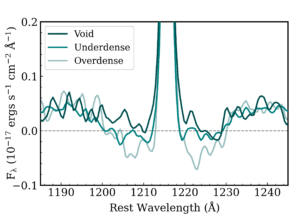Evidence for Large Scale Neutral Hydrogen Gas Absorption in the Environments of Lyman Alpha Emitters
February 14, 2024
By statistically combining the spectra of thousands of distant galaxy spectra, in a technique astronomers call “stacking”, we can see very faint spectral features that are otherwise undetectable in individual galaxies. In a previous post, we shared the work of Researcher Dustin Davis. By stacking 50K very faint galaxy spectra together a whole slew of ultra low brightness features are seen that reveal details about the stellar composition and star formation history of the average galaxy in the sample.

The stacks also revealed a puzzling feature that caused HETDEX researchers to spend months figuring out if it was an artifact of the data processing pipeline. This new result is presented in this recently published article in the Astrophysical Journal. Graduate Student Laurel Weiss has spent the better part of her PhD thesis trying to figure out what might cause the absorption. Every test she performed pointed to the troughs being a feature of the distant galaxies and not a feature of the instrument or processing software.
Because the absorption is seen around the Lyman Alpha emission line, a line caused by the transition of ionized hydrogen atoms from the first ionized state back to ground level, it suggests the absorption is likely also related to hydrogen gas. Absorption means the neutral hydrogen gas is absorbing UV radiation behind the gas in our line of sight.. The analysis reveals clear absorption wings around the Lyα emission, extending approximately 2000 km/s both redward and blueward of the central line. Indicating the neutral gas is very large in its spatial extent, or the result of strong gas flows, or possibly a combination of both.

To model the absorption and emission Laurel Weiss and collaborators present a theory in which the absorption is from neutral gas surrounding the LAE that absorbs background UV radiation in the line of sight of the observer. The animation on the left demonstrates the basic idea. Background radiation, likely from nearby galaxies in a clustered environment, is absorbed by the gas that is seen in front of it.
The model is supported by an interesting observation in the sample. When divided into different density environments, it appears the absorption is strongest in denser regions. The depth of the absorption is dependent on the local density of objects near the Lyα emitting galaxies, indicating that in more clustered environments the background UV radiation that is being absorbed is brighter which naturally makes sense if there is a higher density of galaxies.

HETDEX’s exploration of Lyα spectral profiles, as detailed in the paper, opens a window into the dynamic and intricate nature of the cosmos. From the revelation of absorption wings to the density-dependent trends, each observation brings us closer to unlocking the cosmic secrets encoded in the light emitted by galaxies. As HETDEX continues its mission, this newly found feature opens a wide range of future studies into the large scale structure or the early universe.
Meet the Researcher
Laurel Weiss is a Graduate Student at the University of Texas at Austin.

